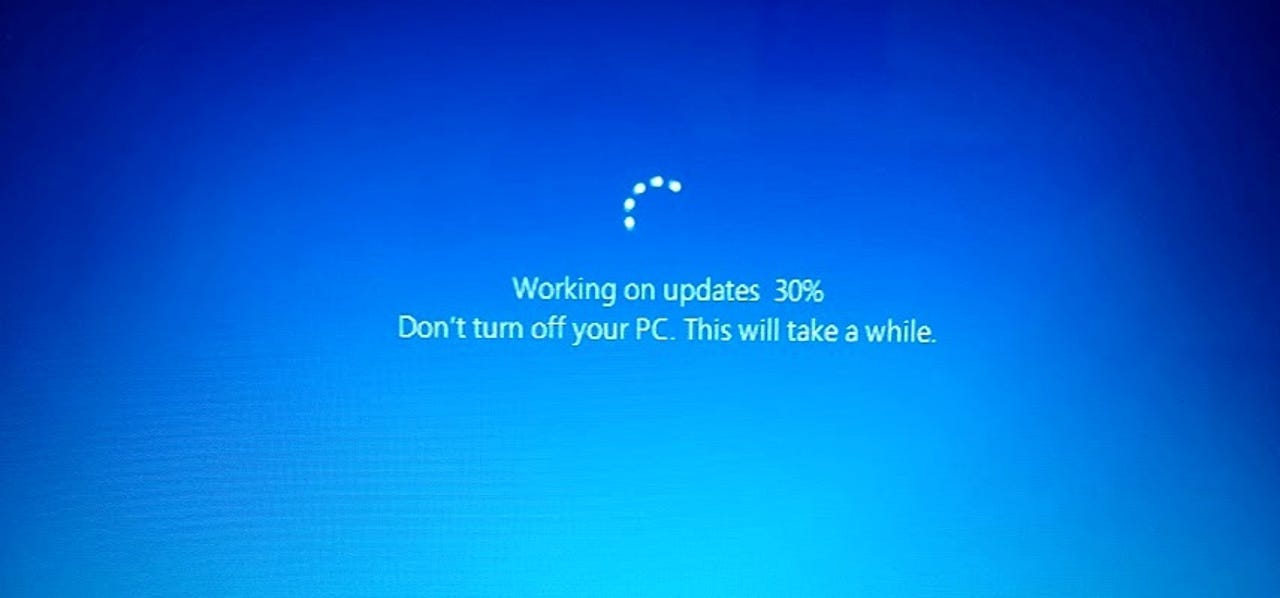Microsoft August 2019 Patch Tuesday fixes 93 security bugs


On the second Tuesday of the month -- as clockwork -- Microsoft released its monthly rollup of security updates known as Patch Tuesday.
This month, Microsoft patched 93 security flaws and published two security advisories with mitigations for two security-related issues impacting the company's products & services.
Unlike in previous months, none of the vulnerabilities that have been patched today were under attack, or had their details publicly disclosed online.
The RDS RCEs
But while security researchers say that all security bugs are important, the "stars" of this month's Patch Tuesday are the four remote code execution bugs Microsoft fixed in the Windows Remote Desktop Services (RDS) component -- CVE-2019-1181, CVE-2019-1182, CVE-2019-1222, and CVE-2019-1226.
Of the four, the first two are the biggest threats.
In a blog post, Simon Pope, Director of Incident Response for the Microsoft Security Response Center (MSRC), said the two bugs are "wormable," akin to the now-infamous BlueKeep (CVE-2019-0708) bug that Microsoft patched in RDS in May.
This means attackers can exploit the bugs to take over a computer and then spread to other computers without any user interaction.
Patching CVE-2019-1181 and CVE-2019-1182 is of the utmost urgency, and for good reasons.
Other patched vulnerabilities
But the four remote code execution (RCE) bugs in the RDS component are not the only RCEs patched this month.
There are also seven RCEs impacting the Chakra scripting engine (included in Microsoft Edge and other Microsoft apps), two RCEs in Microsoft Hyper-V virtual machine hypervisor technology, six RCEs in the Microsoft Graphics component, one in Outlook, two in Word, two in the Windows DHCP client, two in the older Scripting Engine component, and one in the VBScript engine.
And there is also a patch for a bug in the shadowy CTF protocol that impacts all Windows versions since Windows XP.
All in all, the August 2019 Patch Tuesday is both bulky and critical. Of the 93 vulnerabilities Microsoft patched today, 29 are rated Critical and 64 are rated Important in severity.
Furthermore, with this ocassion, Microsoft also wanted to remind users that Windows 7 and Windows Server 2008 R2 will be out of extended support and no longer receiving updates as of January 14, 2020.
"We strongly recommend that you update any computers running Windows 7 or Windows Server 2008 R2 so you will continue receiving security updates," the company said.]
Other non-Microsoft security updates
Since the Microsoft Patch Tuesday is also the day when other vendors also release security patches, it's also worth mentioning that Adobe, SAP, and VMWare have also published their respective security updates earlier today.
Of the three, Adobe's security updates are the largest, with fixes for Photoshop, Experience Manager, Acrobat/Reader, the Creative Cloud desktop app, Prelude, Premiere Pro, Character Animator, and After Effects. Of note, there are no Flash security updates this month.
More in-depth information on today's Patch Tuesday updates is available on Microsoft's official Security Update Guide portal. You can also consult the table embedded below, this Patch Tuesday report generated by ZDNet, or these ones, put together by Trend Micro and the SANS Internet Storm Center.
| Tag | CVE ID | CVE Title |
|---|---|---|
| Online Services | ADV190014 | Microsoft Live Accounts Elevation of Privilege Vulnerability |
| Active Directory | ADV190023 | Microsoft Guidance for Enabling LDAP Channel Binding and LDAP Signing |
| HTTP/2 | CVE-2019-9513 | HTTP/2 Server Denial of Service Vulnerability |
| HTTP/2 | CVE-2019-9512 | HTTP/2 Server Denial of Service Vulnerability |
| HTTP/2 | CVE-2019-9511 | HTTP/2 Server Denial of Service Vulnerability |
| HTTP/2 | CVE-2019-9518 | HTTP/2 Server Denial of Service Vulnerability |
| HTTP/2 | CVE-2019-9514 | HTTP/2 Server Denial of Service Vulnerability |
| Microsoft Bluetooth Driver | CVE-2019-9506 | Encryption Key Negotiation of Bluetooth Vulnerability |
| Microsoft Browsers | CVE-2019-1193 | Microsoft Browser Memory Corruption Vulnerability |
| Microsoft Browsers | CVE-2019-1192 | Microsoft Browsers Security Feature Bypass Vulnerability |
| Microsoft Dynamics | CVE-2019-1229 | Dynamics On-Premise Elevation of Privilege Vulnerability |
| Microsoft Edge | CVE-2019-1030 | Microsoft Edge Information Disclosure Vulnerability |
| Microsoft Graphics Component | CVE-2019-1154 | Windows Graphics Component Information Disclosure Vulnerability |
| Microsoft Graphics Component | CVE-2019-1143 | Windows Graphics Component Information Disclosure Vulnerability |
| Microsoft Graphics Component | CVE-2019-1144 | Microsoft Graphics Remote Code Execution Vulnerability |
| Microsoft Graphics Component | CVE-2019-1152 | Microsoft Graphics Remote Code Execution Vulnerability |
| Microsoft Graphics Component | CVE-2019-1078 | Microsoft Graphics Component Information Disclosure Vulnerability |
| Microsoft Graphics Component | CVE-2019-1158 | Windows Graphics Component Information Disclosure Vulnerability |
| Microsoft Graphics Component | CVE-2019-1150 | Microsoft Graphics Remote Code Execution Vulnerability |
| Microsoft Graphics Component | CVE-2019-1151 | Microsoft Graphics Remote Code Execution Vulnerability |
| Microsoft Graphics Component | CVE-2019-1153 | Microsoft Graphics Component Information Disclosure Vulnerability |
| Microsoft Graphics Component | CVE-2019-1145 | Microsoft Graphics Remote Code Execution Vulnerability |
| Microsoft Graphics Component | CVE-2019-1148 | Microsoft Graphics Component Information Disclosure Vulnerability |
| Microsoft Graphics Component | CVE-2019-1149 | Microsoft Graphics Remote Code Execution Vulnerability |
| Microsoft JET Database Engine | CVE-2019-1155 | Jet Database Engine Remote Code Execution Vulnerability |
| Microsoft JET Database Engine | CVE-2019-1146 | Jet Database Engine Remote Code Execution Vulnerability |
| Microsoft JET Database Engine | CVE-2019-1147 | Jet Database Engine Remote Code Execution Vulnerability |
| Microsoft JET Database Engine | CVE-2019-1156 | Jet Database Engine Remote Code Execution Vulnerability |
| Microsoft JET Database Engine | CVE-2019-1157 | Jet Database Engine Remote Code Execution Vulnerability |
| Microsoft Malware Protection Engine | CVE-2019-1161 | Microsoft Defender Elevation of Privilege Vulnerability |
| Microsoft NTFS | CVE-2019-1170 | Windows NTFS Elevation of Privilege Vulnerability |
| Microsoft Office | CVE-2019-1201 | Microsoft Word Remote Code Execution Vulnerability |
| Microsoft Office | CVE-2019-1200 | Microsoft Outlook Remote Code Execution Vulnerability |
| Microsoft Office | CVE-2019-1199 | Microsoft Outlook Memory Corruption Vulnerability |
| Microsoft Office | CVE-2019-1205 | Microsoft Word Remote Code Execution Vulnerability |
| Microsoft Office | CVE-2019-1218 | Outlook iOS Spoofing Vulnerability |
| Microsoft Office | CVE-2019-1204 | Microsoft Outlook Elevation of Privilege Vulnerability |
| Microsoft Office SharePoint | CVE-2019-1202 | Microsoft SharePoint Information Disclosure Vulnerability |
| Microsoft Office SharePoint | CVE-2019-1203 | Microsoft Office SharePoint XSS Vulnerability |
| Microsoft Scripting Engine | CVE-2019-1133 | Scripting Engine Memory Corruption Vulnerability |
| Microsoft Scripting Engine | CVE-2019-1141 | Chakra Scripting Engine Memory Corruption Vulnerability |
| Microsoft Scripting Engine | CVE-2019-1131 | Chakra Scripting Engine Memory Corruption Vulnerability |
| Microsoft Scripting Engine | CVE-2019-1196 | Chakra Scripting Engine Memory Corruption Vulnerability |
| Microsoft Scripting Engine | CVE-2019-1197 | Chakra Scripting Engine Memory Corruption Vulnerability |
| Microsoft Scripting Engine | CVE-2019-1140 | Chakra Scripting Engine Memory Corruption Vulnerability |
| Microsoft Scripting Engine | CVE-2019-1139 | Chakra Scripting Engine Memory Corruption Vulnerability |
| Microsoft Scripting Engine | CVE-2019-1194 | Scripting Engine Memory Corruption Vulnerability |
| Microsoft Scripting Engine | CVE-2019-1195 | Chakra Scripting Engine Memory Corruption Vulnerability |
| Microsoft Windows | CVE-2019-1163 | Windows File Signature Security Feature Bypass Vulnerability |
| Microsoft Windows | CVE-2019-1162 | Windows ALPC Elevation of Privilege Vulnerability |
| Microsoft Windows | CVE-2019-1188 | LNK Remote Code Execution Vulnerability |
| Microsoft Windows | CVE-2019-1198 | Microsoft Windows Elevation of Privilege Vulnerability |
| Microsoft Windows | CVE-2019-1177 | Windows Elevation of Privilege Vulnerability |
| Microsoft Windows | CVE-2019-1186 | Windows Elevation of Privilege Vulnerability |
| Microsoft Windows | CVE-2019-1168 | Microsoft Windows p2pimsvc Elevation of Privilege Vulnerability |
| Microsoft Windows | CVE-2019-1176 | DirectX Elevation of Privilege Vulnerability |
| Microsoft Windows | CVE-2019-1174 | Windows Elevation of Privilege Vulnerability |
| Microsoft Windows | CVE-2019-1173 | Windows Elevation of Privilege Vulnerability |
| Microsoft Windows | CVE-2019-1175 | Windows Elevation of Privilege Vulnerability |
| Microsoft Windows | CVE-2019-1179 | Windows Elevation of Privilege Vulnerability |
| Microsoft Windows | CVE-2019-1180 | Windows Elevation of Privilege Vulnerability |
| Microsoft Windows | CVE-2019-1178 | Windows Elevation of Privilege Vulnerability |
| Microsoft Windows | CVE-2019-1172 | Windows Information Disclosure Vulnerability |
| Microsoft Windows | CVE-2019-0716 | Windows Denial of Service Vulnerability |
| Microsoft XML | CVE-2019-1187 | XmlLite Runtime Denial of Service Vulnerability |
| Microsoft XML Core Services | CVE-2019-1057 | MS XML Remote Code Execution Vulnerability |
| Visual Studio | CVE-2019-1211 | Git for Visual Studio Elevation of Privilege Vulnerability |
| Windows - Linux | CVE-2019-1185 | Windows Subsystem for Linux Elevation of Privilege Vulnerability |
| Windows DHCP Client | CVE-2019-0736 | Windows DHCP Client Remote Code Execution Vulnerability |
| Windows DHCP Server | CVE-2019-1213 | Windows DHCP Server Remote Code Execution Vulnerability |
| Windows DHCP Server | CVE-2019-1206 | Windows DHCP Server Denial of Service Vulnerability |
| Windows DHCP Server | CVE-2019-1212 | Windows DHCP Server Denial of Service Vulnerability |
| Windows Hyper-V | CVE-2019-0718 | Windows Hyper-V Denial of Service Vulnerability |
| Windows Hyper-V | CVE-2019-0717 | Windows Hyper-V Denial of Service Vulnerability |
| Windows Hyper-V | CVE-2019-0714 | Windows Hyper-V Denial of Service Vulnerability |
| Windows Hyper-V | CVE-2019-0715 | Windows Hyper-V Denial of Service Vulnerability |
| Windows Hyper-V | CVE-2019-0720 | Hyper-V Remote Code Execution Vulnerability |
| Windows Hyper-V | CVE-2019-0965 | Windows Hyper-V Remote Code Execution Vulnerability |
| Windows Hyper-V | CVE-2019-0723 | Windows Hyper-V Denial of Service Vulnerability |
| Windows Kernel | CVE-2019-1164 | Windows Kernel Elevation of Privilege Vulnerability |
| Windows Kernel | CVE-2019-1169 | Win32k Elevation of Privilege Vulnerability |
| Windows Kernel | CVE-2019-1227 | Windows Kernel Information Disclosure Vulnerability |
| Windows Kernel | CVE-2019-1159 | Windows Kernel Elevation of Privilege Vulnerability |
| Windows Kernel | CVE-2019-1228 | Windows Kernel Information Disclosure Vulnerability |
| Windows Kernel | CVE-2019-1190 | Windows Image Elevation of Privilege Vulnerability |
| Windows RDP | CVE-2019-1181 | Remote Desktop Services Remote Code Execution Vulnerability |
| Windows RDP | CVE-2019-1225 | Remote Desktop Protocol Server Information Disclosure Vulnerability |
| Windows RDP | CVE-2019-1226 | Remote Desktop Services Remote Code Execution Vulnerability |
| Windows RDP | CVE-2019-1223 | Windows Remote Desktop Protocol (RDP) Denial of Service Vulnerability |
| Windows RDP | CVE-2019-1224 | Remote Desktop Protocol Server Information Disclosure Vulnerability |
| Windows RDP | CVE-2019-1182 | Remote Desktop Services Remote Code Execution Vulnerability |
| Windows RDP | CVE-2019-1222 | Remote Desktop Services Remote Code Execution Vulnerability |
| Windows Scripting | CVE-2019-1183 | Windows VBScript Engine Remote Code Execution Vulnerability |
| Windows Shell | CVE-2019-1184 | Windows Elevation of Privilege Vulnerability |
| Windows SymCrypt | CVE-2019-1171 | SymCrypt Information Disclosure Vulnerability |
Windows 10 apps: Which are worth keeping? Which ones should you dump?
More vulnerability reports:
- Microsoft names top security researchers, zero-day contributors
- Apple expands bug bounty to macOS, raises bug rewards
- Clever attack uses SQLite databases to hack other apps, malware servers
- Researchers find security flaws in 40 kernel drivers from 20 vendors
- Microsoft warns of two new 'wormable' flaws in Windows Remote Desktop Services
- Vulnerability in Microsoft CTF protocol goes back to Windows XP
- Google will now pay up to $30,000 for reporting a Chrome bug CNET
- Top 10 app vulnerabilities: Unpatched plugins and extensions dominate TechRepublic